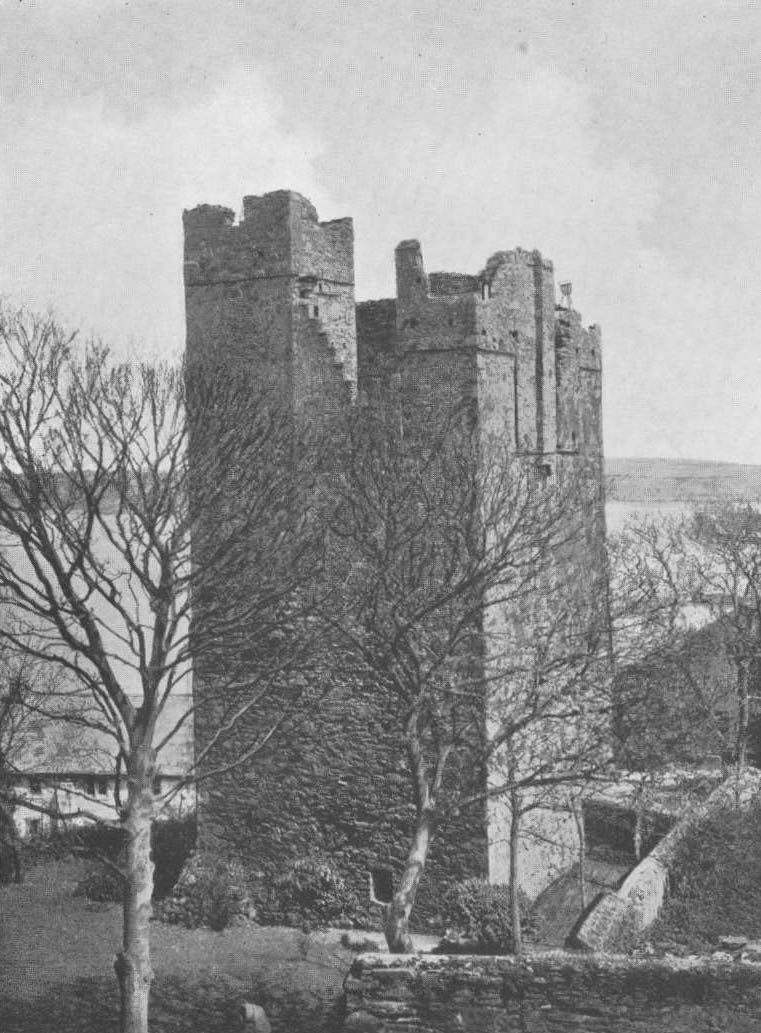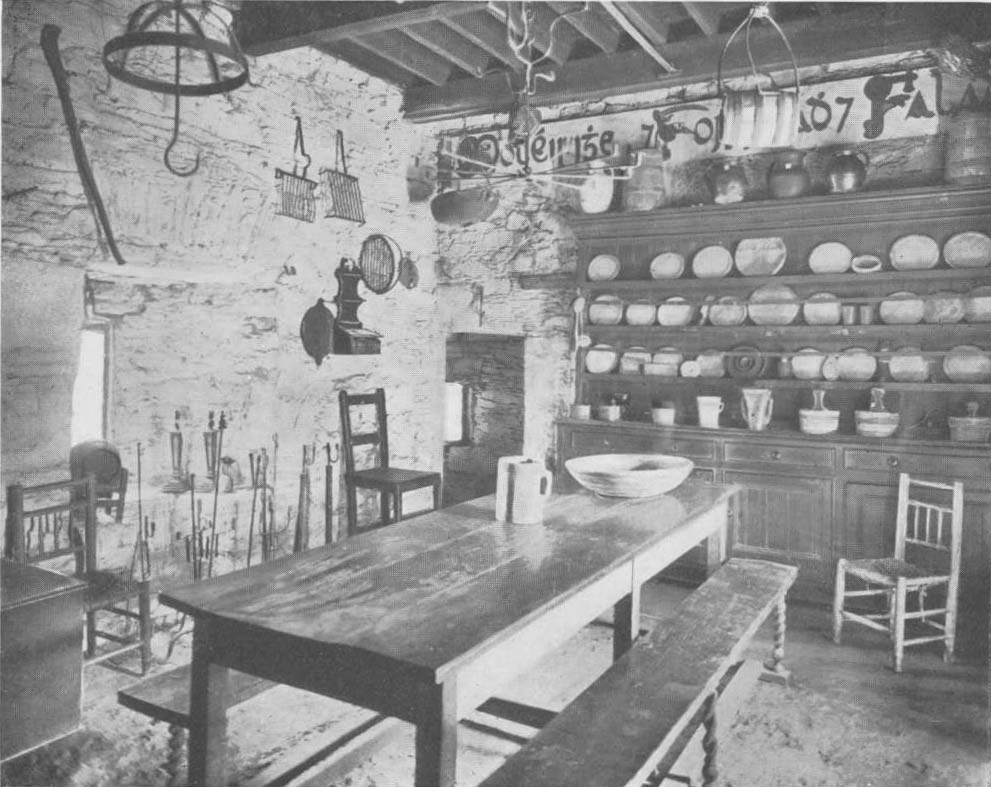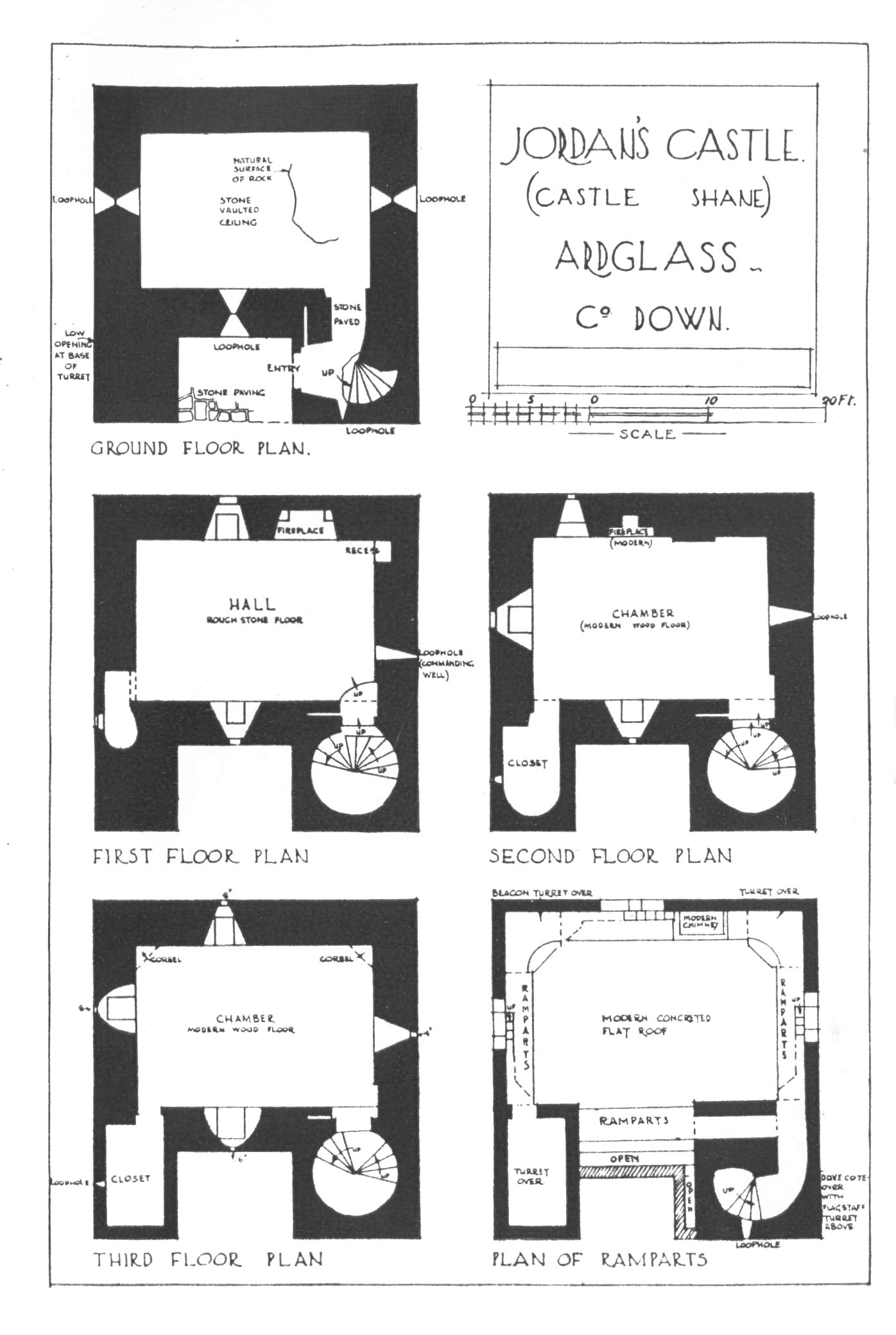A GUIDE TO JORDAN'S CASTLE
and F. J. Bigger Collection of Antiquities
ARDGLASS, CO. DOWN
THIS castle stands close to the harbour in the town of Ardglass. Its early history is somewhat obscure. It is known, however, that a certain Jordan de Saukville, a military adventurer, was in the time of John de Courcy settled at Ardglass, and was in the year 1217 confirmed by Henry III. in his possessions there. The next authentic reference is to a defence of the castle made by Simon Jordan (presumably a descendant of Jordan de Saukville) against the adherents of Shane O'Neill for three years, ending with its relief by Lord Deputy Mountjoy in 1601. The eighteenth-century historian, Harris, says that "it is most probable that Jordan's Castle was erected by one of that family, whose arms (a cross and three horseshoes) are fixed in a stone near the top." This stone is not now to be found. There are several other small castles of the same type in Ardglass, and there is some ground for the belief that they were the defensible residences and store-houses of merchants. In 1911 this castle was acquired by the late Mr. Francis Joseph Bigger, of Belfast, who, in a very public-spirited manner repaired the structure and made it available to visitors under the name of Castleshane. Subsequently he used the castle for the storage and display of a collection of antiquities. On his death in 1926 the structure was presented by his executor, Dr. Joseph Bigger, to the State, on condition that, with its contents, it should be preserved as an Ancient Monument.
The tower consists of four superimposed single chambers, each about 20 feet by 13 feet. On the north face are two rectangular projections, one containing a stone spiral stair, the other an inner closet at each level, communicating by holes in the floor. Architecturally there is little evidence to give a definite date to the structure. The masonry is blue stone rubble with a little freestone in quoins and window jambs. Some of the window details suggest 14th century, but there has been so much reconstruction at these points that it is difficult to make any suggestions as to date. The chamber at the ground level is unfloored, and the irregular surface of the outcropping rock may be seen. This may have been a store-house. The main room is apparently that on the first floor, which contains its original stone floor supported on a pointed barrel vault. The floors on the second and third storeys are at the original levels, but are of modern construction, with the beams going at right angles to the original direction. The concrete roof is also an addition. The wall tops retain their stone-flagged rampart walks and archery turrets; also a large aperture, probably for pouring melted lead on attackers. The turret to the north-west contains a dove-cote, the nest-holes of which are contemporary with the main structure. The interest of the whole mainly lies in the preservation of the complete outer shell of a castle of this "Peel tower" type, with many of its original internal features intact. Its interior, which is gloomy even now, although the windows have probably been enlarged, gives an excellent idea of what life must have been like in such a structure when it was inhabited by a family with, in all probability, a considerable retinue of soldiers or servants.

Photo. View from South-West. R. J. Welch.
(The dove-cote is in the turret to the left.)
List of Exhibits in F. J. Bigger Collection, and later acquisitions.
FIRST FLOOR.
ARTICLES OF DOMESTIC USE.
(1) Two copper dish covers.
(2) St. Brigid's Cross (made of rush each 1st February).
(3) "Churn" made from last sheaf remaining standing in harvest (believed to typify harvest goddess).
(4) Toasting fork.
(5) Bog butter.
(6) Hand wash-board.
(7) File for documents.
(8) Two wooden ladles.
(9) Stone carving of mantelpiece from destroyed Custom House, Dublin (gift of J. D. Weir, 1927).
(10) Candle lantern.
(11) Keg on stand.
(12) Collection of candlesticks, various types, amongst which the following may be noted:—
(a) Rush light.
(b) Wooden candlesticks with mirror set into base.
(c) Stone candlesticks.
(d) Iron candlestick on six straight rods.
(e) Candlestick with pointed end for sticking into earthen floor.
(13) Iron cleaver (all metal).
(14) Chest.
(15) and (16) Rush chairs.
(17) Gridirons.
(18) Gridiron with round handle for slinging over fire.
(19) Griddle.
(20) Salt box containing horn spoons.
(21) Wooden churn head.
(22) Toasting fork.
(23) Form with antique supports,
(24) Glazed earthenware jar.
(25) Stoops.
(26) Irish oak table.
(27) Two black glazed pitchers (Youghal).
(28) Red earthenware jar.
(29) Unglazed earthenware jar.
(30) Dresser.
(31) Horn cups.
(32) Wooden noggins.
(33) Pepper pounder.
(34) Form similar to (23).
(35) Three wooden drinking cups of the "Mether" type.
(36) Piggins.
(37) Iron stand.
(38) Mirror in case.
(39) Griddle sling.
(40) Hanging trivet.
(41) "Wag-on-the-wall" clock.
(42) Folding ladder.
(43) Baker's tray.
(44) Three-legged pot.
(45) Copper saucepan.
(46) Metal spoon.
(47) Candle box and moulds.
(48) Bowl.
(49) Collection of toasting racks, including easel type.
(49A) Toasting rack used as fender.
(50) Turnspit jack.
(51) Cruisie.
(52) Candle socket.
(53) Steel for use with flint to produce fire.
(54) Candle snuffer.
(55) Trivet.
(56) Jointed candle-holders.
(57) Earthenware jar.
(58) Bull ring.
(59) Door handle and latch.
(60) Stone mortar with iron and stone pestles.
(61) Two fan bellows (one on a wooden stand).
(62) "Swey," or swinging arm, for holding vessels over fire.
(63) Collection of saucepans.
(64) Copper kettles.
(65) Trivet of heart-shaped design (possibly wedding-gift).
(66) Candle box.
(67) High wooden chair (said to have been used for pinioning in Carrickfergus Jail).
(68) Spit rack supports.
(69) Settle.
(70) Spoon box.
(71) Meat hooks.
(72) Meat hanger.
(73) Candelabrum.
(74) Firkin suspended by hanger.
(75) Hollow wooden vessels; one hanging, one on floor (probably troughs).

Photo. Interior, First Floor. R. J. Welch.
(Showing part of F. J. Bigger Collection.)
SECOND FLOOR.
OBJECTS ASSOCIATED WITH WAR, SPORT, TRAVELLING, PUNISHMENT, &c.
(81) Ram's horns.
(82) Pikes.
(83) Straight-backed three-legged chair.
(84) Short spears of javelin type.
(85) Red deer antlers received from Clandeboye, 1912.
(86) "Sword" of swordfish.
(87) Stone axes (modern hafts).
(88) Horses' bits and trappings (one of Inniskilling Dragoons).
(89) Powder horns (2).
(90) Knives in double and triple scabbards.
(91) Canoe mooring pegs and paddles.
(92) Stone hammer.
(93) Quiver with arrows.
(94) Blunderbuss (small).
(95) Ankle irons, 4 sets of.
(96) Blunderbuss (large).
(97) Elk's head (large).
(98) Whalebone.
(99) Stirrup irons.
(100) Handcuffs.
(101) Padlock ("Thomas Paris, Stourbridge").
(102) Bayonets, various types.
(103) Crossbow.
(104) Man traps.
(105) Fused glass from Dublin Custom House fire, bearing impress of duty stamp, 15/- (gift of J. D. Weir, 1927).
(106) Badger trap.
(107) Large block of whalebone,
(108) Horse pistol.
(109) Mace.
(110) Muskets and other firearms (various).
(111) Swords (various).
(111A) Claymore handle found at castle (blade modern).
(112) Powder satchel.
(113) Cannon balls.
(114) Leg weight.
THIRD FLOOR.
OBJECTS ASSOCIATED WITH INDUSTRY, ART, WOMEN AND CHILDREN.
(120) Beetles (3).
(121) Two weaver's candlesticks and blacksmith's candle-holder (received from Clandeboye, 1903).
(122) "Traw hook," or rope winder.
(123) Toy ship (iron).
(124) Sock of wooden plough.
(125) Metal puzzle.
(126) Toy dresser.
(127) Toy cup and saucer (metal and in one piece).
(128) Sandal.
(129) Smith's pincers.
(130) Knee guard.
(131) Toy bedstead (wrought iron).
(132) "Portion of stand for linen yarn. Used in Henry Monro's shop in Lisburn (from a relative, 1905)."
(133) Small washing tub.
(134) Elk's antler (1).
(135) Iron-sheathed chest.
(136) Flax beaters.
(137) Metal trinket stand.
(138) Grubbers (miniature).
(139) Pipe kiln.
(140) Wrought-iron pitchfork head (received from Toomebridge, 1907).
(141) Steelyards.
(142) Billhook.
(143) "Serpent" (musical instrument).
(144) Blacksmith's hoof support.

General Plan
First published 1929. Printed under the Authority of His Majesty's Stationery Office by M'Caw, Stevenson & Orr, Ltd., Belfast. C698. Wt Pubns.32/7. 6/29. 1,000. Gp.15.
